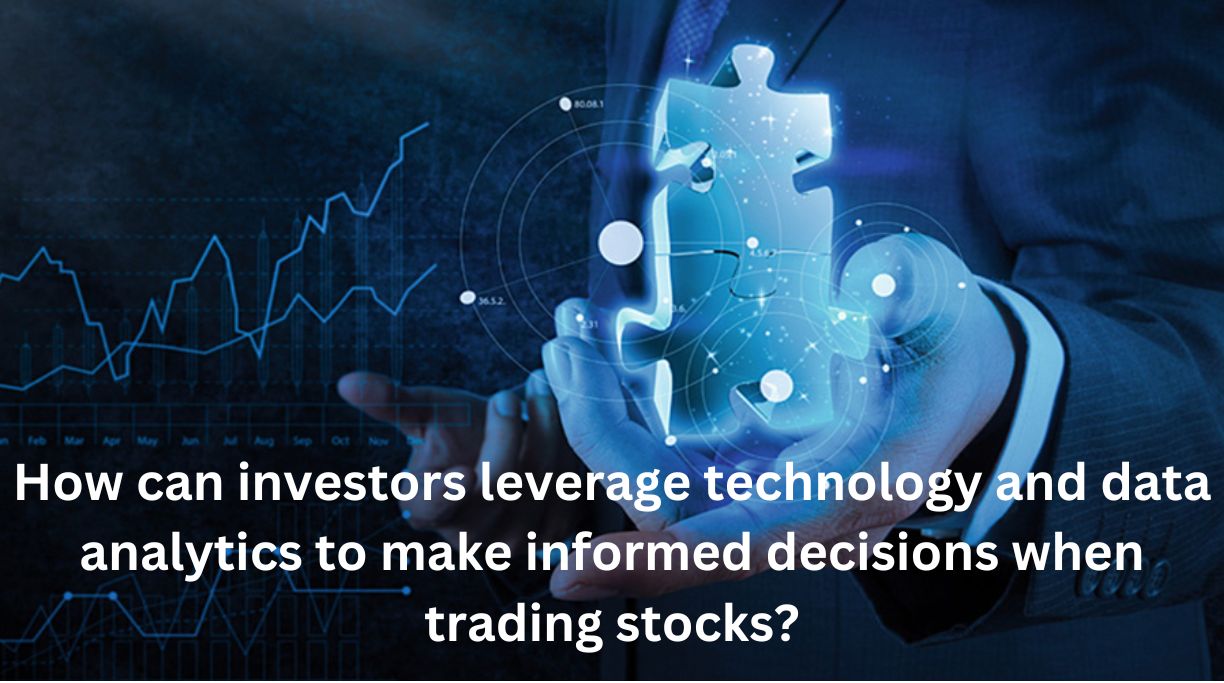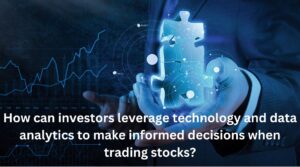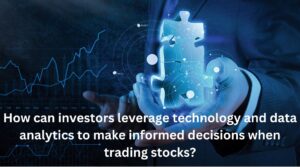The world of stock market investing has changed dramatically, largely due to the influence of technology and data analytics. We will explore in-depth how investors may use data analytics and technology to their advantage while trading stocks in this post.
How Does Technology Affect Stock Trading?
Trading Systems That Are Automated
The world of stock trading has changed dramatically with the introduction of automated trading systems, or ATS. These sophisticated algorithm-driven systems automatically execute trades according to preset parameters. Their significance stems from their capacity to remove emotional biases from trading decisions, guaranteeing speedy and accurate transaction execution. Without being constrained by human hesitancy or impetuous behavior, traders can take advantage of market possibilities. The ability of Automated Trading Systems to process enormous volumes of data at speeds that are unfathomable to humans is proof of their efficiency. In markets where split-second judgments can mean the difference between profit and loss, this speed is especially critical. Additionally, ATS makes it feasible to watch the market around-the-clock, offering a level of attentiveness that is unattainable for humans.
Analysis of Real-Time Market Data
Having access to up-to-date market information is essential for profitable stock trading. Instantaneous study of market trends, stock prices, and breaking news has been made easier by technology. With the help of this real-time information, investors can act quickly and decisively. By utilizing sophisticated analytical instruments, traders may recognize trends, spot irregularities, and gauge sentiment in the market instantly, adding to a more thorough comprehension of the state of the market today. The precision of Real-Time Market Data Analysis is just as important as speed. Investors can tailor their data streams to concentrate on particular industries, companies, or indications of the world economy. By using a customized strategy, traders can stay ahead of market changes by receiving the most impactful and relevant information.
Trading Apps for Mobile
The world of stock trading has never been more convenient thanks to the rise of mobile trading apps. With the palm of their hands, investors can now monitor their portfolios, place trades, and get vital market data thanks to these applications. Because of these apps’ mobility, investors are no longer restricted to desktop computers or actual trading floors. Mobile trading apps increase accessibility and offer flexibility to a wider group of investors. Whether traveling, commuting, or just spending time away from a computer, investors can maintain a real-time connection to the market. These applications’ user-friendly interfaces democratize financial markets by making stock trading more accessible to novices.
In stock trading, what does data analytics mean?
Analytics for Predictive
The foundation of data analytics in stock trading is predictive analytics, which forecasts future market movements by utilizing sophisticated statistical algorithms and historical data. Predictive models are used by investors to plan their investments, predict stock fluctuations, and pinpoint possible entry and exit opportunities. The capacity to identify patterns and extrapolate them into forecasts is the fundamental component of predictive analytics. Investors can make data-driven judgments by looking at trading volumes, historical price trends, and other market indicators. In particular, machine learning algorithms are particularly good at identifying intricate patterns that can be difficult for humans to analyze, giving investors insightful information about future changes in the market.
Sentiment Analysis
Being able to read market sentiment is essential to profitable stock trading. Sentiment analysis, which is frequently driven by natural language processing algorithms, is the process of assessing the feelings and thoughts of the general public about particular stocks or the market at large. Traders are able to predict future changes in the market by assessing the overall sentiment of investors. Sentiment analysis algorithms can process a wealth of textual data from social media, financial news, and online forums. Trading decisions can be influenced by attitude toward a specific stock, which adds another level of information beyond standard market indicators. By incorporating sentiment analysis into investment techniques, traders may remain aware of the emotional pulse of the market.
Analyzing Historical Data
Making educated selections and comprehending the nature of the stock market require a basic comprehension of historical data analysis. In order to find patterns, correlations, and trends, historical data analysis entails looking at previous price movements, trading volumes, and other pertinent variables. This retrospective view offers background information and insights into the performance of particular assets in different market scenarios. By backtesting trading techniques using historical data, investors can determine the viability of these strategies based on how they would have performed in previous market circumstances. Additionally, by highlighting the possible drawbacks of particular investment choices, historical data analysis supports risk assessment.
Read Also:
- How can investors leverage technology and data analytics to make informed decisions when trading stocks?
- What role does diversification play in building a resilient investment portfolio, particularly in the stock market?
- How can content planning enhance the digital marketing strategy for Real Estate Investment?
- How does the current geopolitical landscape influence investment strategies, and what precautions should investors take in response to these geopolitical factors?
What Advantages Do Technology and Data Analytics Offer?
Enhanced Precision
The significant improvement in accuracy is one of the main benefits of using technology and data analytics in stock trading. While human error and prejudice are common in traditional techniques of analysis, sophisticated algorithms and data-driven models can process enormous volumes of data with unmatched accuracy. Analytical tools and automated systems are excellent at processing large amounts of data and spotting patterns that the human eye would miss. This increased precision is especially noticeable in domains like price prediction, where predictive analytics systems are able to more accurately predict future market movements. Accurate data gives investors the ability to make more realistic decisions, which results in profitable trades and well-thought-out investment plans.
Mitigation of Risk
Any investor should take risk mitigation seriously, and technology and data analytics work hand in hand to manage and reduce risks. Using predictive modeling and historical data analysis, investors can evaluate the possible risks involved in particular investment choices. For example, real-time implementation of risk management procedures by Automated Trading Systems can automatically set off actions to protect investments and limit losses. Investors can make better decisions about risk tolerance and portfolio diversification by using data analytics to learn about the past performance of assets in different market scenarios.
Making Decisions Quickly
Making decisions quickly makes all the difference in the fast-paced world of stock trading between taking advantage of chances and missing them. With the help of technology, investors can digest data quickly and make judgments instantly. With real-time market data analysis, traders can be sure they have access to the most recent data on stock prices, market trends, and world events that could affect the market. Mobile trading apps give investors instant access to their portfolios and the most recent market data, which speeds up decision-making even further. One major benefit that enables investors to take advantage of new opportunities and prevent losses is the capacity to respond swiftly to shifting market conditions.
Conclusion
The integration of technology and data analytics has transformed the stock trading industry, providing investors with hitherto unheard-of benefits. With improved decision-making precision, efficient risk management, and prompt responsiveness, these developments enable investors to confidently traverse the ever-changing market environment. Adopting these technologies helps investors succeed in a constantly changing financial landscape while also optimizing trading techniques. An era of informed judgments that lead to sustainable growth and success in stock trading has begun, thanks to the convergence of human intuition and technology prowess.
FAQs (Frequently Asked Questions)
- What is the significance of data analytics in stock trading?
- Data analytics in stock trading is crucial for providing valuable insights into market trends, helping investors make informed decisions. It leverages historical data, predictive analytics, and sentiment analysis to enhance the accuracy of trading strategies.
- Are there risks associated with relying solely on technology?
- Yes, there are risks. Overreliance on technology, without human oversight, can lead to unexpected errors or system failures. It’s essential for investors to strike a balance between technology and human judgment for a well-rounded approach to decision-making.
- How can investors balance the use of algorithms and human judgment?
- Striking the right balance involves integrating the speed and precision of algorithms with the nuanced decision-making capabilities of humans. Investors should use technology as a tool for analysis but also consider the qualitative aspects that human judgment brings to the table.
- What are the key features to look for in trading platforms?
- When evaluating trading platforms, look for features such as user-friendly interfaces, real-time data feeds, security protocols, and the ability to execute trades swiftly. A reliable platform should also offer diverse analytical tools and educational resources.
- How can beginners start leveraging technology for informed trading?
- Beginners can start by familiarizing themselves with user-friendly trading platforms and educational resources. Gradually incorporating analytical tools and staying informed about market trends will empower them to leverage technology for more informed stock trading decisions.








